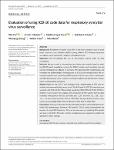Evaluation of using ICD‐10 code data for respiratory syncytial virus surveillance
Cai, Wei
Tolksdorf, Kristin
Hirve, Siddhivinayak
Schuler, Ekkehard
Zhang, Wenqing
Haas, Walter
Buda, Silke
Background
Respiratory syncytial virus (RSV) is the most common cause of acute lower respiratory tract infection (ALRI) in young children. ICD‐10‐based syndromic surveillance can transmit data rapidly in a standardized way.
Objectives
We investigated the use of RSV‐specific ICD‐10 codes for RSV surveillance.
Methods
We performed a retrospective descriptive data analysis based on existing ICD‐10‐based surveillance systems for ALRI in primary and secondary care and a linked virological surveillance in Germany. We described RSV epidemiology and compared the epidemiological findings based on ICD‐10 and virological data. We calculated sensitivity and specificity of RSV‐specific ICD‐10 codes and in combination with ICD‐10 codes for acute respiratory infections (ARI) for the identification of laboratory‐confirmed RSV infections.
Results
Based on the ICD‐10 and virological data, epidemiology of RSV was described, and common findings were found. The RSV‐specific ICD‐10 codes had poor sensitivity 6% (95%‐CI: 3%‐12%) and high specificity 99.8% (95%‐CI: 99.6%‐99.9%). In children <5 years and in RSV seasons, the sensitivities of RSV‐specific ICD‐10 codes combined with general ALRI ICD‐10 codes J18.‐, J20.‐ and with J12.‐, J18.‐, J20.‐, J21.‐, J22 were moderate (44%, 95%‐CI: 30%‐59%). The specificities of both combinations remained high (91%, 95%‐CI: 86%‐94%; 90%, 95%‐CI: 85%‐94%).
Conclusions
The use of RSV‐specific ICD‐10 codes may be a useful indicator to describe RSV epidemiology. However, RSV‐specific ICD‐10 codes underestimate the number of actual RSV infections. This can be overcome by combining RSV‐specific and general ALRI ICD‐10 codes. Further investigations are required to validate this approach in other settings.
Files in this item

